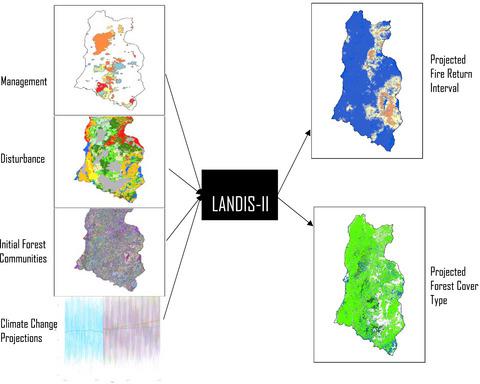当前位置:
X-MOL 学术
›
J. Appl. Ecol.
›
论文详情
Our official English website, www.x-mol.net, welcomes your
feedback! (Note: you will need to create a separate account there.)
Co‐designed management scenarios shape the responses of seasonally dry forests to changing climate and fire regimes
Journal of Applied Ecology ( IF 5.0 ) Pub Date : 2020-05-06 , DOI: 10.1111/1365-2664.13630 Charles J. Maxwell 1 , Josep M. Serra‐Diaz 2, 3 , Robert M. Scheller 1 , Jonathan R. Thompson 4
中文翻译:

共同设计的管理方案塑造了季节性干旱森林对变化的气候和火灾状况的响应
更新日期:2020-05-06
Journal of Applied Ecology ( IF 5.0 ) Pub Date : 2020-05-06 , DOI: 10.1111/1365-2664.13630 Charles J. Maxwell 1 , Josep M. Serra‐Diaz 2, 3 , Robert M. Scheller 1 , Jonathan R. Thompson 4
Affiliation

|
- Climate change is altering disturbance regimes and recovery rates of forests globally. The future of these forests will depend on how climate change interacts with management activities. Forest managers are in critical need of strategies to manage the effects of climate change.
- We co‐designed forest management scenarios with forest managers and stakeholders in the Klamath ecoregion of Oregon and California, a seasonally dry forest in the Western US subject to fire disturbances. The resultant scenarios span a broad range of forest and fire management strategies. Using a mechanistic forest landscape model, we simulated the scenarios as they interacted with forest growth, succession, wildfire disturbances and climate change. We analysed the simulations to (a) understand how scenarios affected the fire regime and (b) estimate how each scenario altered potential forest composition.
- Within the simulation timeframe (85 years), the scenarios had a large influence on fire regimes, with fire rotation periods ranging from 60 years in a minimal management scenario to 180 years with an industrial forestry style management scenario. Regardless of management strategy, mega‐fires (>100,000 ha) are expected to increase in frequency, driven by stronger climate forcing and extreme fire weather.
- High elevation conifers declined across all climate and management scenarios, reflecting an imbalance between forest types, climate and disturbance. At lower elevations (<1,800 m), most scenarios maintained forest cover levels; however, the minimal intervention scenario triggered 5 × 105 ha of mixed conifer loss by the end of the century in favour of shrublands, whereas the maximal intervention scenario added an equivalent amount of mixed conifer.
- Policy implications. Forest management scenarios that expand beyond current policies—including privatization and aggressive climate adaptation—can strongly influence forest trajectories despite a climate‐enhanced fire regime. Forest management can alter forest trajectories by increasing the pace and scale of actions taken, such as fuel reduction treatments, or by limiting other actions, such as fire suppression.
中文翻译:

共同设计的管理方案塑造了季节性干旱森林对变化的气候和火灾状况的响应
- 气候变化正在改变全球森林的干扰制度和恢复率。这些森林的未来将取决于气候变化如何与管理活动相互作用。森林管理者迫切需要战略来管理气候变化的影响。
- 我们与俄勒冈州和加利福尼亚州克拉马斯生态区的森林管理者和利益相关者共同设计了森林管理方案,这是美国西部季节性干旱的森林,容易遭受火灾的干扰。由此产生的场景涵盖了广泛的森林和火灾管理策略。使用机械的森林景观模型,我们模拟了场景与森林生长,演替,野火干扰和气候变化的相互作用。我们分析了模拟,以(a)理解情景如何影响火情,(b)估算每种情景如何改变潜在的森林组成。
- 在模拟时间范围内(85年),方案对火灾状况有很大影响,火灾轮换期从最小管理方案中的60年到工业林业风格管理方案中的180年不等。无论采用何种管理策略,在更强的气候强迫和极端火灾天气的推动下,特大火灾(> 100,000公顷)的发生频率预计都会增加。
- 在所有气候和管理情景下,高海拔针叶树的数量均下降,反映出森林类型,气候和干扰之间的不平衡。在低海拔(<1,800 m),大多数情景保持森林覆盖水平;然而,到 本世纪末,最小的干预方案引发了5×10 5公顷的混合针叶树损失,有利于灌木丛,而最大的干预方案则增加了相当数量的混合针叶树。
- 政策含义。尽管气候改善了火灾,但超出当前政策范围(包括私有化和积极的气候适应)的森林管理方案仍可能强烈影响森林的发展轨迹。森林管理可以通过提高行动的步伐和规模(例如减少燃料的处理)或限制其他行动(例如灭火)来改变森林的轨迹。











































 京公网安备 11010802027423号
京公网安备 11010802027423号